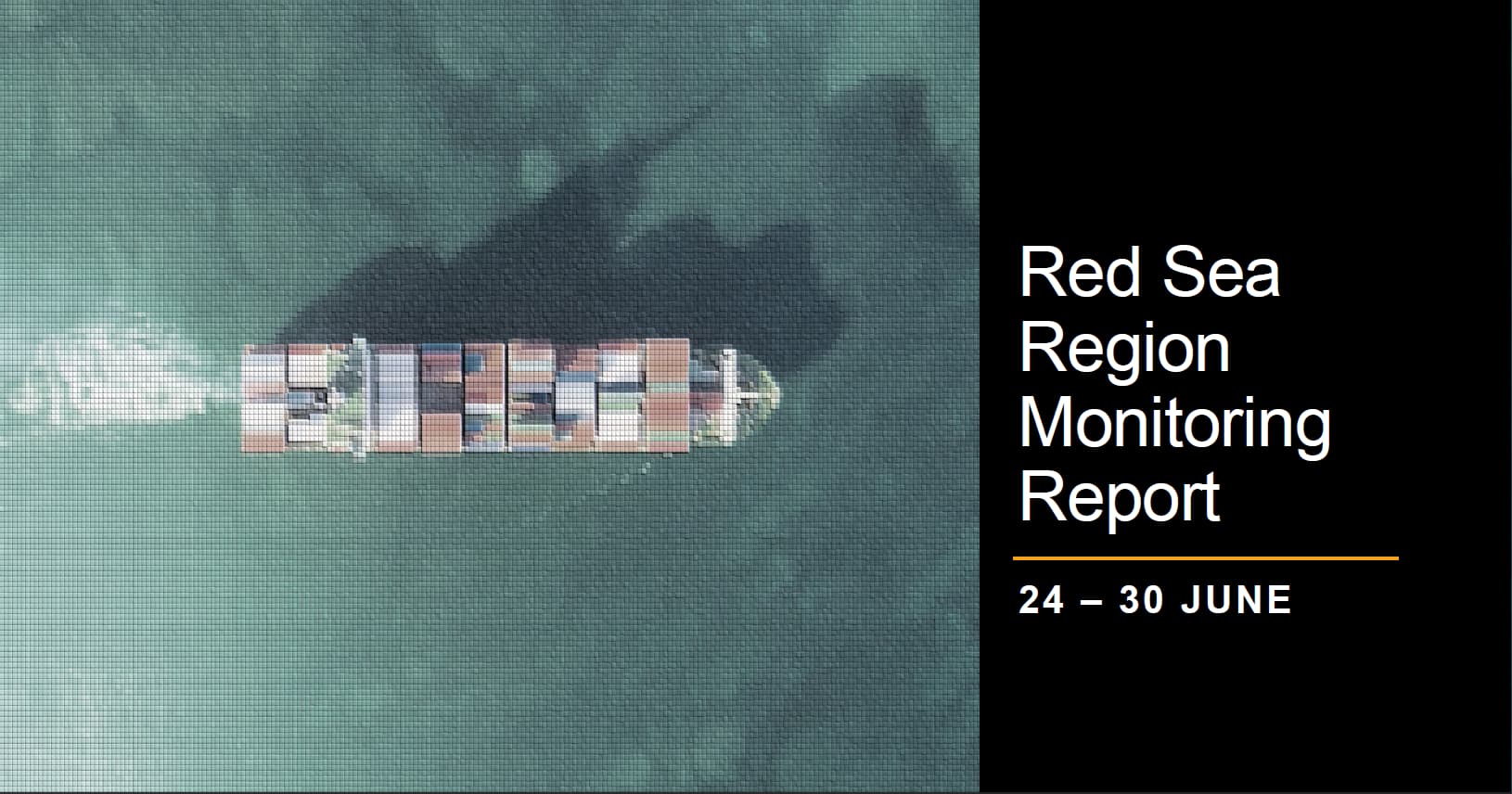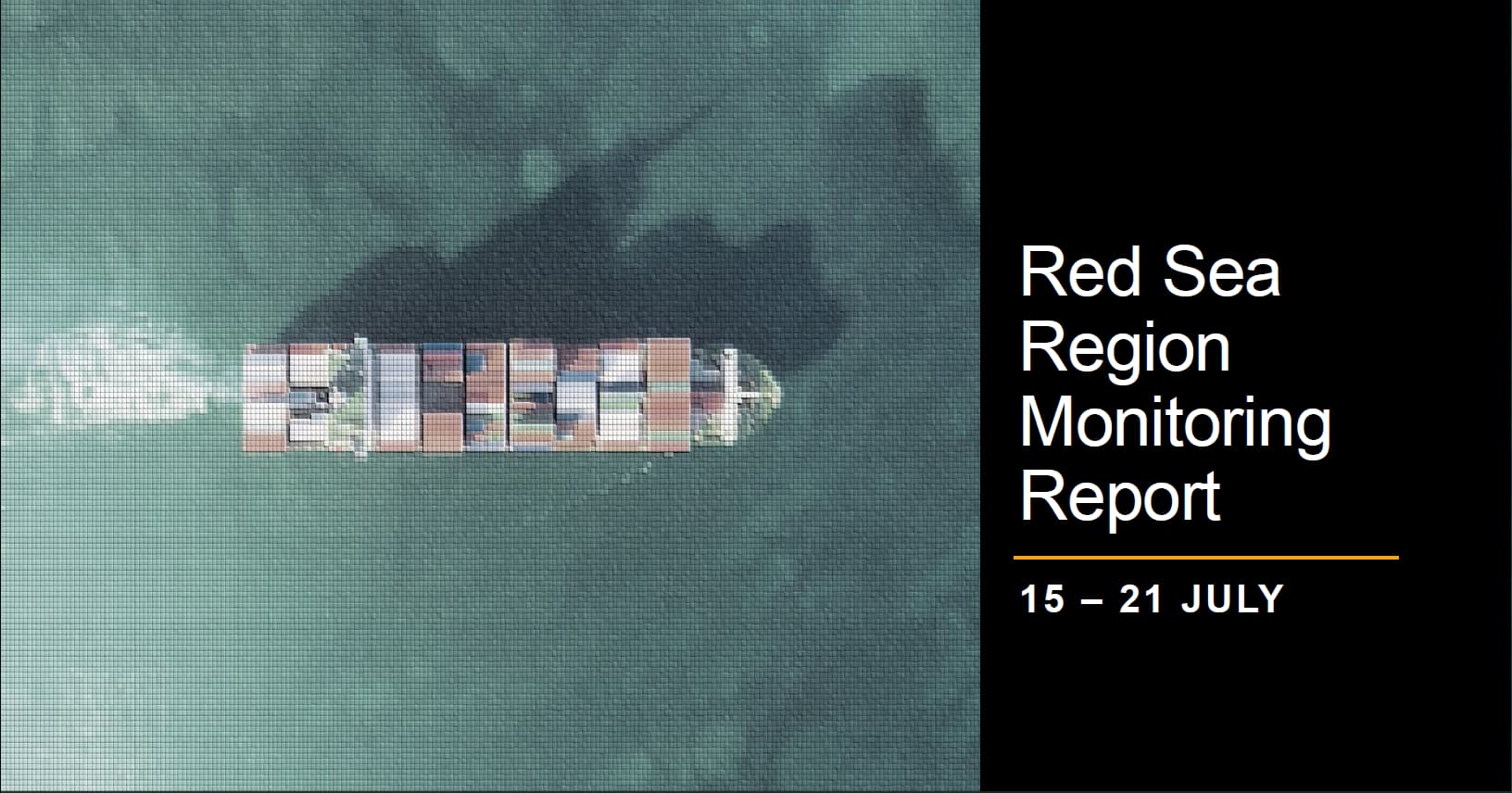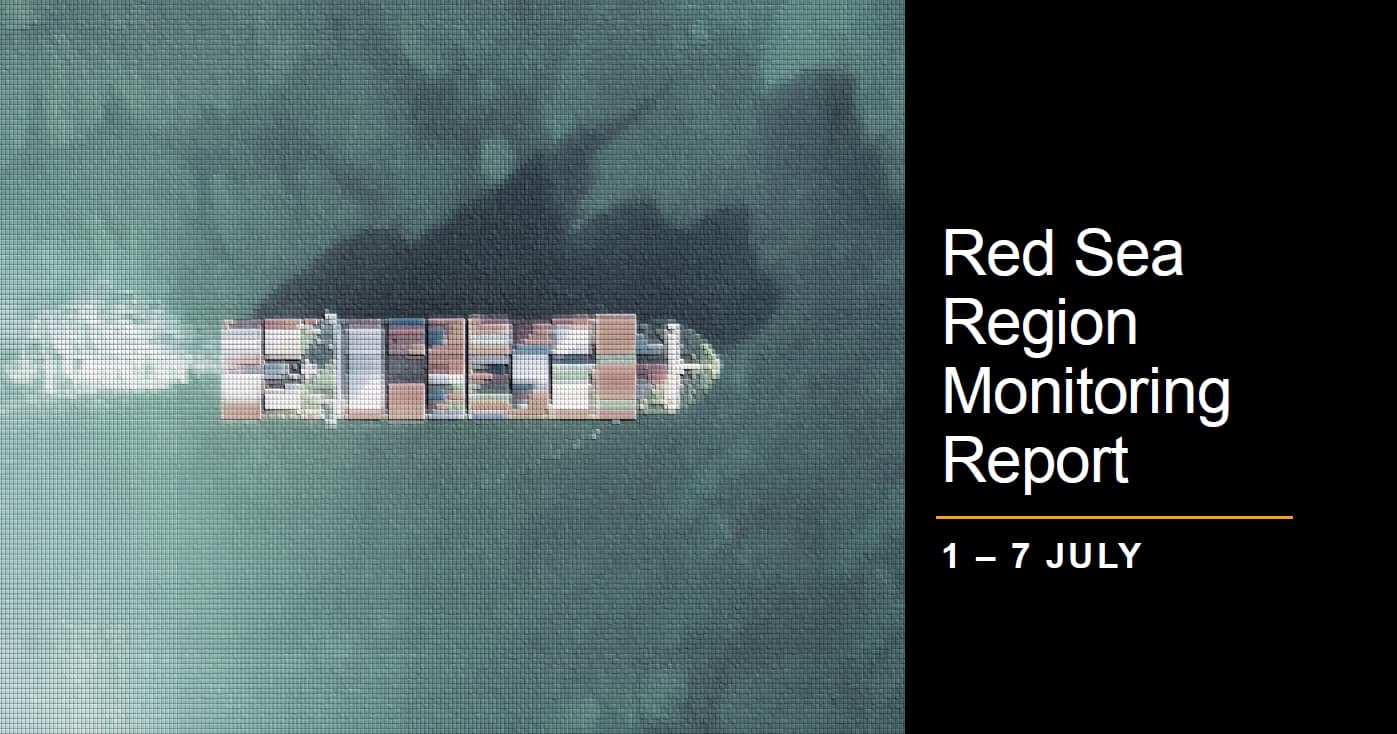KEY DEVELOPMENTS – COMMERCIAL INCIDENTS
During the monitoring period 15-21 April Regal Maritime Solutions (RMS) identified the following incidents in the Red Sea and Gulf of Aden region:
There were no reported incidents targeting commercial vessels in the Red Sea region
over the monitoring period.

KEY DEVELOPMENTS – MILITARY ACTIVITY
During the monitoring period 15-21 April RMS identified the following incidents involving US coalition forces in the Red Sea and Gulf of Aden region, obtained from military and open sources:
MISSILE INTERCEPT: On 13 April (reported on 15 April) at approximately 1900 local time, whilst Iran and its proxies launched strikes at Israel in an unprecedented air attack, Houthi militants launched one anti-ship ballistic missile (ASBM) toward the Gulf of Aden from a Houthi controlled area in Yemen. No vessels were struck and no injuries or damage were reported by US, coalition, or commercial ships in the area.
UAV INTERCEPT: On 14 April (reported on 15 April) between 0400 and 2115 local times US forces successfully destroyed four uncrewed aerial vehicles (UAVs) in Houthi-controlled areas of Yemen in self-defense. This was in addition to seven UAVs reportedly destroyed on the ground in Yemen during Iran’s assault on Israel.
UAV INTERCEPT: On 16 April between 1050 and 1130 local time US forces engaged and destroyed two unmanned aerial vehicles (UAV) in Houthi-controlled areas in Yemen. There were no injuries or damage reported by US, coalition or commercial ships.
EUNAVFOR UPDATE: On 15 April the German frigate Hessen ended its 58-day combat mission for EUNAVFOR mission ASPIDES to protect merchant vessels from attacks by the Houthi group in the Red Sea. Germany’s armed forces, the Bundeswehr, reported the warship concluded its deployment on Saturday and left the mission area. The German Frigate Hamburg will replace it under the EU mission Aspides in August. The Houthis said that EU’s mission to confront them had failed.
The head of a EUNAVFOR mission ASPIDES claimed the operation had met its goals, but freight traffic cannot increase without more warships considering the large distances that needs to be covered.
KEY DEVELOPMENTS – HOUTHI MISSILE STATISTICS

Figures 1 and 2 identifies the number of missiles, UAV, USVs and UUVs launched, or prepared to be imminently launched, by Houthi militants from Yemen targeting commercial and naval vessels in the Red Sea and Gulf of Aden regions. Figures have incorporated statistics from vessels hit, near misses and pre- emptive strikes on-land in Yemen by US-led Coalition forces but not those resulting from large scale coordinated military action. In some cases the destined target of Houthi weapons including destroyed on-land in Yemen cannot not be verified and has therefore been categorised as ‘Not Known’ (NK). Where no dates are provided there were no reported incidents or data available for that period.
ANALYSIS: Houthi activity will continues to disrupt commercial shipping in the Red Sea and Gulf of Aden region. It saw a drop in attacks at the end of as a consequence of US strikes on Houthi controlled territory which caused temporary disruption to their activities. This lull continued into the first 2 weeks of April, which saw a smaller number of attacks occur compared to several weeks prior and very likely influenced by Iranian plans for it and its proxies to launch coordinated airstrikes at Israel on 13-14 April. This saw 86 Houthi UAV and missile launches intercepted and disrupted. The Houthis will likely be replenishing its weapons stock for recommencement of attacks on commercial shipping in support of Iran’s continuous shadow war against Israel in the coming weeks.
REGIONAL DEVELOPMENTS – IRAN-ISRAEL TENSIONS
During the monitoring period 15-21 April RMS identified the following key regional developments:
On 15 April and following Iran’s direct air attack on Israel over 13-14 April the Israeli Defense Force (IDF) intercepted an unmanned aerial vehicle (UAV) launched from Yemen near the Israeli port city of Eilat in the Red Sea.
US Central Command destroyed more than 80 drones and at least six ballistic missiles during Iran’s attack on Israel. This included a ballistic missile and seven UAVs on the ground in Houthi- controlled areas of Yemen ready to launch.
The US confirmed it would not participate in any Israeli counteroffensive against Iran.
On 16 April the IDF killed a senior Hezbollah commander, Ismail Yusaf Baiz, from its elite Radwan Forces, in an airstrike in the Kfar Dounin area in southern Lebanon. He was killed alongside another senior operative.
On 17 April Hezbollah fired missiles and drones at Israel’s northern Bedouin village of Arab al- Aramshe, targeting an “Israeli military facility” and injured at least 19 people. The strikes were in response Ismail Yusaf Baiz’s killing a day earlier.
The US, Israel and 46 other nations issued a joint statement “unequivocally” condemning Iran’s “large-scale attack” on Israel. Meanwhile the G7 Nations began working on a package of coordinated measures they could take against Iran.
On 18 April Iranian President Ebrahim Raisi confirmed Iran’s attack against Israel demonstrated the Iranian military’s strength and shattered Israel’s perceived “hegemony” whilst “limited” in nature.
Iran’s Foreign Minister Hossein Amir-Abdollahian warned Israel against further military action at the UN Security Council on 18 April warning Israel not to violent its sovereignty to avoid a further Iranian escalation.
In the early hours of 19 April three explosions were reported near the Shekari army airbase Isfahan, south of Tehran. The presumed Israeli attack was aimed at an air defence radar site, which formed part of Iran’s defensive infrastructure protecting its nuclear facility in Natanz. The UN International Atomic Energy Agency (IAEA) confirmed that the Iranian nuclear facilities were safe and secure.
In addition Syrian state media confirmed that Israel struck air defence systems in southern Syria early on 19 April causing “material losses”.
A missile used in the presumed Israeli attack on a military base near the Iranian city of Isfahan is believed to have been an air-to-surface missile called ‘The Rampage’. The missile is considered able to evade Iranian radar systems, a capability believed to have been deployed as a warning to Iran from conducting future direct attacks on Israel.
Following the Isfahan attack world leaders called for restraint from both Iran and Israel as to avoid further escalation of major conflict in the Middle East.
Meanwhile Iranian Foreign Minister Hossein Amir-Abdollahian downplayed the presumed Israeli attack in claiming that there is no evidence to indicate Israel was responsible and that the incident involved three small drones that were successfully intercepted by Iranian forces. His response can be interpreted as Iran intending not to escalate the situation further.
During the evening of 19 April, a large explosion was reported in Iraq at the Kalsu military facility, Babil governorate, approximately 50km south of Baghdad. The facility is used as a base by Iraq’s Popular Mobilization Forces (PMF), an umbrella group consisting of dozens of armed groups supported by Iran. At least one PMF fighter was killed and eight wounded. The US has confirmed the explosion was not caused by US military operations.
On 21 April Iran’s Supreme Leader Ayatollah Ali Khamenei praised Iran’s armed forces for their “success” after they launched their attack on Israel. Khamenei acknowledged the large number of missiles and drones launched by Iran and intercepted by Israel, but clarified the objective of the attack was to demonstrate Iran’s capabilities rather than its physical impact. Khamenei told commanders to “learn the enemy’s tactics” in the event of future conflict. News outlets interpreted Khamenei’s comments as calming fears of a potential all-out conflict between both nations.
On 21 April at least five rockets were launched from the area of Zummar, Iraq towards a US military base in Syria situated east of Deir Ezzor. Explosions were heard in the area, but no casualties reported.
This is the first attack on US forces in the region since early February and days after explosions were reported at a military facility in Iraq used by the Iran-backed Popular Mobilisations Forces (PMF) believed to be attributed to Israeli forces.
The US Pentagon confirmed US military assets moved to the Middle East prior to Iran’s strikes are set to remain in place for the time being.
The UK Middle East minister Lord Ahmad of Windsor intends to visit the British naval base in Bahrain on Monday 22 April amid concerns Iran will now increase proxy attacks on Red Sea shipping as Iran and Israel have stepped back from the potential direct conflict.
Houthi Chief Abdul Malik al-Houthi has blasted Saudi Arabia and UAE for allegedly pleasing Israel and warned Riyadh against potential normalisation deal with the Jewish State. Yemen’s rebel leader alleged that he Saudi and UAE removed Quranic verses from school textbooks to please Israel.
The last reported location of the Iranian intelligence vessel the Behshad was on 18 April in the Persian Gulf in Iranian territorial waters. It was located in the vicinity of coordinates 26° 59′ 26.2″ N, 056° 24′ 35.2″ E located approximately 5NM south of Banda Abbas, Iran and south west of the island of Hormuz.

ASSESSMENT
- The risk of direct state to state conflict between Iran and Israel has lowered following recent escalatory events. Both countries are expected to return to its shadow war via its agents and proxies in the region which will likely intensify over the coming months. Both will seek to avoid direct conflict with each other given recent international pressure to avoid escalation.
- Iran is expected to revert to using its tried and tested method of utilising proxies to pressure Israel. This will involve Iranian commanders in Yemen ordering an increase of Red Sea attacks by Houthi militants and an upsurge in attacks by Hezbollah fighters in Lebanon.
- The expected Israeli offensive on Rafah in Gaza after failed negotiations between Israel and Hamas is expected to occur after the Jewish Passover celebration due to end on 30 April. This will likely increased Houthi targeting of shipping in the region.
- The return of sustained Houthi targeting of commercial shipping in the Red Sea and Gulf of Aden region will be determined by its and Iran’s ability to replenish Houthi UAV and missiles stocks following the coordinated air strikes on Israel on 13-14 April.
- Israel will continue to maintain an aggressive posture toward Iran over the coming months and both countries are likely to continue to target each others assets across the region in its continued shadow war with Iran utilising its proxies across the region.
- Iran will continue to smuggle weapon components to Houthi militants via shipping vessels and smuggling networks within the territory controlled by Yemen’s internationally recognised government (IRG).
- Houthi use of outdated and inaccurate data pertaining to target identification will likely remain inaccurate in the short term increasing the risk to non Israeli, US or UK linked vessels. Houthi militants are expected to take additional precautions not to target Chinese and Russian vessels in the region
- The US and its partners will continue to conduct pre-emptive strikes against Houthi targets on-land in an attempt to degrade Houthi military capability and prevent it to be used as a platform to target Israel in support of further potential Iranian attacks.
- The US will continue to intensify efforts to intercept vessels smuggling weapon components from Iran to the Houthis in Yemen and expand intelligence collection methods to enhance maritime interdiction operations, as well as coordinate military strikes against Houthi weapon sites, facilities and capabilities in Yemen.
- The US government will continue to push for a diplomatic solution for the Israel-Hamas conflict with regional partners due to the ongoing humanitarian crisis in Gaza and attempt to dissuade wider conflict from escalating in the region. The US will attempt to maintain this issue as a separate matter to the current Israel-Iranian situation and continue to pressure Israel to avoid pursuing a ground offensive in Rafah.
- Piracy incidents around the Horn of Africa is expected to continue as a consequence of ongoing insecurity challenges presented in the Red Sea region and the Middle East.
- The Indian navy will continue to utilise coercive measures to resolve piracy incidents and to deter PAG activity in the Indian ocean region.
RECOMMENDATIONS
- Avoid being in vicinity of Iranian Behshad vessel. Avoid where possible transiting locations within the UAE and Iranian coastlines due to the risk from Iranian military boarding parties.
- Be aware of US, coalition or Israeli Navy activity nearby in north of Red Sea, Bab-al-Mandab strait and Gulf of Aden, and Iranian activity in the Arabian sea.
- Communicate with local agents for any local information or intelligence. Monitor trusted media outlets and RMS and other security reporting on developments in the region in case of escalation.
- Vessels operating in the Indian Ocean area are urged to heighten their vigilance due to increased likelihood of Pirate Activity Groups (PAGs) operating in the area.
- Report any Suspicious Sightings and be aware of the risk of Unmanned aerial Vehicle (UAV) / drone and Uncrewed Surface Vehicle (USV) attack.
- Consider utilising a digital monitoring system, which incorporates UAV/UUV drone monitoring to warn of potential attack and use of physical barriers, such as nets and underwater barriers, that can be deployed to prevent UUVs from approaching a ship. These barriers can entangle or obstruct the movement of a UUV..
- Ensure crew conduct drills and training exercises to respond to UUV threats so that they are well-prepared to take appropriate action in the event of an incident.
- Follow guidance on loitering munitions as per the OCIMF website: https://www.ocimf.org/publications/information-papers/loitering-munitions-%E2%80%93-the-threat-to-merchant-ships
- Implement and review BMP5 in particular section 2, which describes non-piracy threats and the Global Anti-Piracy Guide.
- Consider mentioning vessel location to Flag Authorities.
- Inform UKMTO/MSCHoA of vessel movements.
- Ensure radar is kept on.
- Keep VHF Ch16 on and pay attention to advisories. Ensure strict surveillance of communications and establish communication with all approaching vessels.
- Do not allow small boats to approach or dock. Consider utilizing an armed security team aboard.
- Ensure there is Hard Cover available if on deck and that it is accessible.
- Ensure a Secondary Muster Station is considered and identified to crew and not just the citadel.
- Maintain Bridge Watches. (Please be aware at night, small, slow vessels without a wake are difficult to detect on radar). Keep Traffic on Upper Deck to a minimum
- Ensure all fire-fighting equipment is checked and available for immediate use. Including the emergency fire pump and that relevant maintenance has been conducted.





